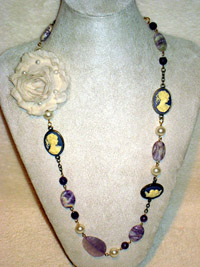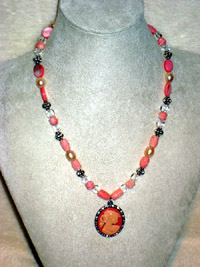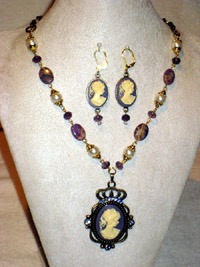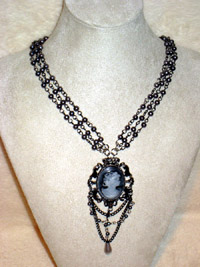Irina's Blog
Timeless, feminine, elegant cameos
September 7, 2011
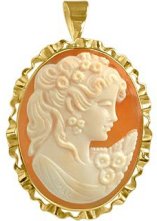 Cameos are back in style just like the whole vintage, history-inspired look is really fashionable right now. But I’ve always liked cameos because they have this amazing timeless beauty and feminine elegance about them.
Cameos are back in style just like the whole vintage, history-inspired look is really fashionable right now. But I’ve always liked cameos because they have this amazing timeless beauty and feminine elegance about them.
So I decided to look back at the cameo history to understand how this beautiful jewellery item originated and what is the story behind it. It’s quite fascinating; here is what I learned... Cameos date to nearly 300 years BC to Alexandria, Egypt where they owe their origins to ancient carving traditions. As far back as 15,000 BC - petroglyphs (figures carved into rock) were used to record significant events and communicate information. In ancient times people used cameos to depict an ethic or moral, or to make a statement about their faith or loyalties.
In the Hellenistic era young women used cameos as charms to express desire. A woman could wear a cameo depicting a dancing Eros as a seductive invitation to love. During the Renaissance, Pope Paul II was an avid cameo collector. According to history, this love ultimately led to his death. His excessive display of carved gems and stones on his fingers kept his hands so cold that he caught the chill that led to his death.
France's Louis XIV, the "Sun King," appointed several advisors to acquire entire collections of ancient cameos and engraved gems. Queen Elizabeth was known to favor cameos to complement her garments, and Catherine the Great had an impressive collection as well. Cameos also enchanted Napoléon, who wore a cameo to his own wedding and founded a school in Paris to teach the art of cameo carving to young apprentices.
Ancient and Renaissance cameos were made from semi-precious gemstones such as onyx or agate. In modern-style cameos, shell and glass are more commonly used materials to produce cameos. They are usually oval shaped and have two contrasting colours - relief surface on a flat surface with a profile of a beautiful woman on it.
At a time when it was very hard and expensive to get miniature portraits done and way before photography was invented, cameos were done (of both men and women, but mostly women) as a way for prospective grooms to have a keepsake of their bride to be, especially if she was from a far distance. This was done mostly by the upper class and nobility as hand-carved cameos were fairly expensive. Later on, the cameos became simply a fashion item worn by women and they were carved after anonymous models. These cameos were quite expensive and were considered a mark of a woman of high standing.
During the mid-19th century, cameos became all the rage when Queen Victoria revived the jewelry piece. Shell had been used by Italian carvers since 1805, and by the Victorian era, was the favorite material of cameo designers. The waters near the Italian town of Torre del Greco were discovered housing an abundance of coral. Victorians believed in the power of coral to ward off evil, and soon began using coral for cameos.
Popular subjects for cameos included depictions of deities from Greek mythology (especially the Three Graces, the daughters of Zeus), the Biblical Rebecca at the well, and the Bacchante maidens adorned with grape leaves in their hair. The Victorians' appreciation for naturalism, especially their love of gardening, was also captured in cameos featuring flowers and trees. Finally, the Victorian woman of means often commissioned a cameo in her likeness, while other artists depicted an idealized woman with an upswept hairstyle and Romanesque features.
“Lava” cameos were especially popular, coveted pieces during the Victorian era. During this period, wealthy families traveled throughout Europe on an extended vacation known as the "Grand Tour." One popular stop along the Grand Tour was the ruins of Pompeii, and wealthy travelers often purchased lava cameos as souvenirs for themselves and as gifts for loved ones back home.
Mt. Vesuvius provided an abundance of lava, a soft and delicate substance, in many colors that carvers used to create intricate designs. The lava cameos often portrayed historical statesmen, philosophers and dignitaries, as well as classical scenes. Lava cameos were less expensive than their precious counterparts and appealed especially to ladies who traveled to Italy. In fact, lava cameos became a status symbol because they showed the observer that the wearer had been on the Grand Tour.
Torre del Greco remains the modern-day capital city of coral and cameos, nestled between the foot of Mount Vesuvio and the Mediterranean Sea, overlooking the bay of Naples in Italy. When I traveled to the beautiful island of Capri in the Mediterranean, I got to see where the cameos originated from and I also brought a beautiful cameo broche-pendant as a souvenir. I’ve included its picture on top of this page.
In our day and age, everyone can have a cameo; they are not reserved for the nobility and super wealthy people like in the days of the past. Now one can get a hand-carved version which would be more expensive or a reproduction done in shell, coral, glass or vinyl. I’m really glad that cameos are back in style so that I can incorporate them in my jewellery designs. Below you'll find some of the necklaces I’ve designed with cameo pendants. Please click on the image to learn more.
Until next time,
Irina K.
Blog Archives:
